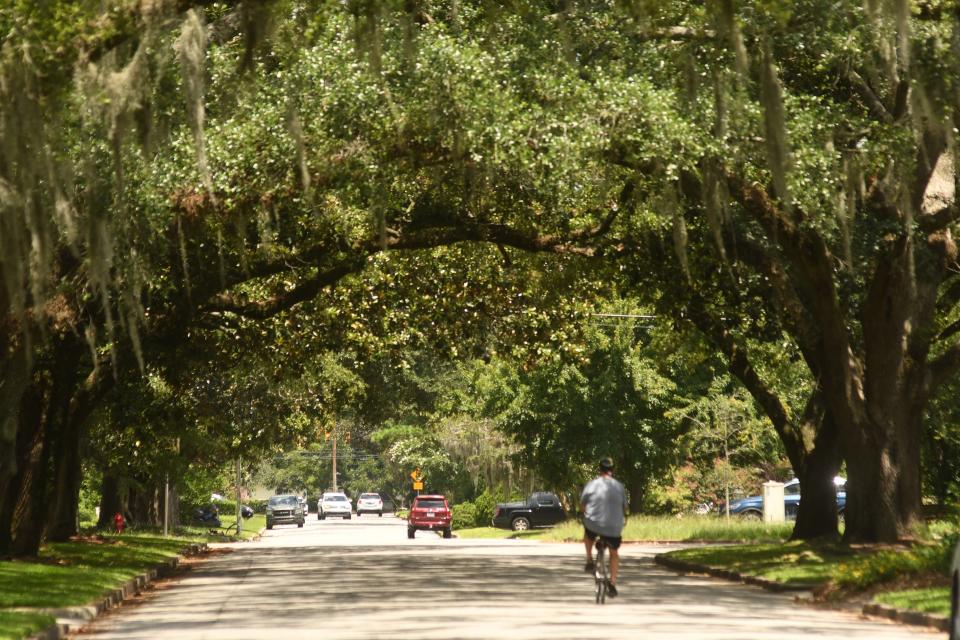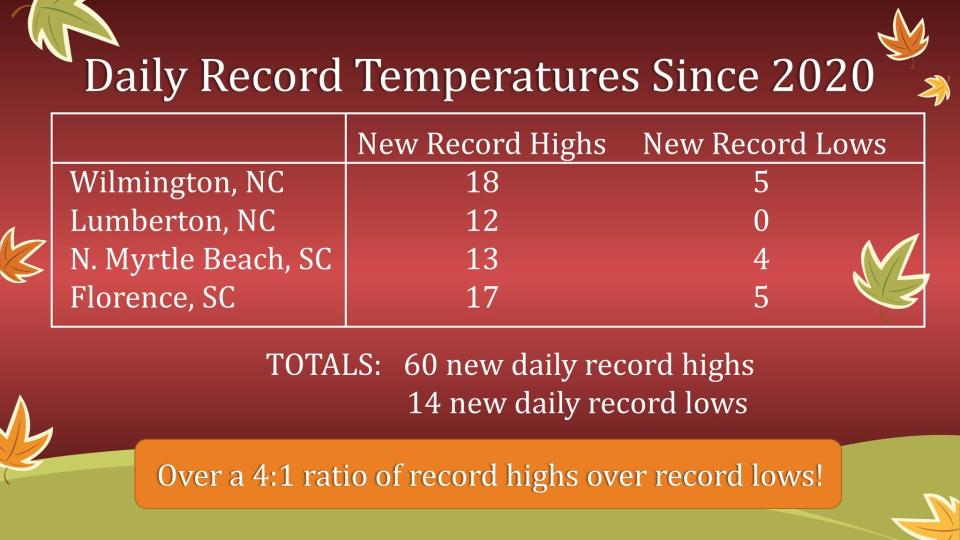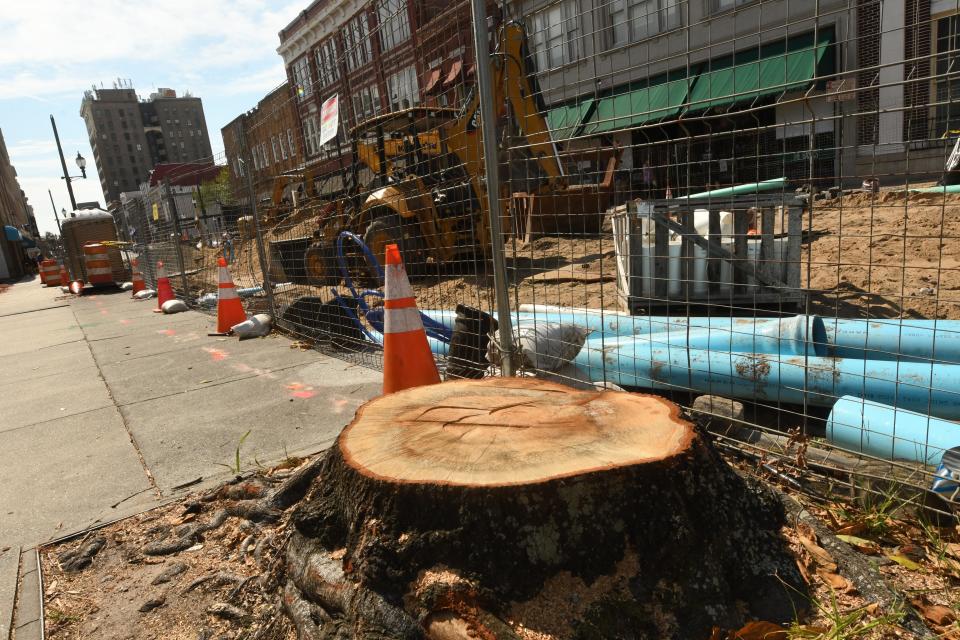Wilmington has lots of trees. Now it is developing a plan to better manage, care for them
Hoping to put its best green foot forward, Wilmington is considering adopting an urban forestry master plan.
The project, which is the city's first attempt to define the city's goals and ambitions for its trees, is looking at ways to improve the health, diversity and population of Wilmington's street trees and green canopy.
According to a survey, the Port City lost 16% of its tree canopy between 2016 and 2020, with storms like Hurricane Florence and development the primary culprits.
But the idea of improving Wilmington's tree stock is more than just to make the Port City look better. Scientists say trees offer a host of benefits beyond beautification and are an especially important tool as cities prepare for the inevitable rise in temperatures and added challenges brought on by warming and more unpredictable weather fueled by climate change.
What is an urban forest?
According to N.C. State University, urban forests − also known as community forests − are defined as a collection of trees in cities and suburban areas. Forests are estimated to cover 35% of urban areas in the U.S., and include trees in parks, along city streets, and on residential properties.
While urban and traditional forests share the same basic elements, namely trees, they have vastly different purposes. Forests in rural and non-developed areas are often managed for timber or wildlife habitat, and thus include tree species that are often geared toward these goals − such as fast-growing trees. But in urban areas officials often plant species that offer long lives, large canopies and are structurally sound.

In the South, that often means fewer pine trees and more hardwood trees in urban and suburban neighborhoods.
According to the tree plan, Wilmington has roughly 32,500 street trees citywide, with nearly 10,100 of those within the city's 1945 corporate limits that run roughly from the Cape Fear River east to Burnt Mill Creek and down to Greenfield Lake.
Why are urban trees important?
Trees in developed areas provide numerous benefits to residents beyond providing habitat for squirrels, birds and scared cats.
Among the best-known benefits is shade, a time-honored tradition that is becoming increasingly important as the world warms and urban areas' plethora of streets, parking lots and roofs amplifies the higher temperatures.
TIMBER FUEL Could wood from NC forests soon be fueling your next airline flight?
Already, warming temperatures are being felt across the Cape Fear region. Last summer, the U.S. National Weather Service in Wilmington reported that Southeastern North Carolina and Northeastern South Carolina had recorded 60 new daily record highs since 2020 compared to 14 new daily record lows.

Of particular concern in cities are urban heat islands, areas where unshaded roads and buildings gain heat during the day and radiate that heat into the surrounding air, leading to "hot spots" that can be several degrees warmer than surrounding areas cooled by trees. Among the biggest emerging problems worrying researchers is the lack of "cool-down" time for buildings and humans due to temperatures staying much warmer at night. Humid nights are dangerous because it makes the body work harder to stay cool, putting a strain on organs such as the heart.
Trees also are fantastic carbon sinks, with a mature tree able to absorb nearly 48 pounds of carbon dioxide - the chief warming greenhouse gas in the atmosphere.
Along with polluting gases, trees also absorb vast amounts of runoff through their roots. According to N.C. State, a forested area absorbs five times as much runoff as a similar sized area covered in asphalt or concrete. Wilmington's study found the city's street trees sequester nearly 88 tons of carbon a year and absorb 1.3 million gallons of rainwater.
Trees also are well-known tools to help people reduce stress, connect with nature, enhance property values, and beautify their homes and neighborhoods.
What happens now?
The city's tree plan includes several recommendations.
Among them is further diversifying the types of trees in Wilmington's inventory to prevent a pest infestation or other event destroying a high percentage of the city's tree canopy. Joe Joyner, a project manager with the Davey Resource Group, which assisted on the tree study, said the Port City has an overabundance of crepe myrtles, at 28% of all street trees, and laurel oaks, at 14%.
"Wilmington is not unique in the Southeast in having a large number of crepe myrtle street trees," he said at a Wilmington City Council meeting earlier this month, noting that they are popular because they don't grow very tall and mature quickly. Joyner added that the laurel oaks are responsible for a disproportionally large number of the city's tree maintenance woes, in parts because many of them are old and reaching the end of their natural lives.

Councilman Neil Anderson asked if overhead power lines along streets were a problem in cities other than Wilmington, where pruning has left many mature trees with V-shapes and leaving them more susceptible to disease and storm damage.
"Utility departments often have different goals in pruning trees than, say, what I would do if I was pruning a tree," Joyner said, referring to priorities by Duke Energy and others to limit power outages caused by falling limbs.
TREE WHISPERERS Ancient NC trees have survived thousands of years. Will they weather climate change?
The tree study also recommends working proactively to strengthen and expand the city's tree canopy and to allocate more resources to areas of Wilmington that don't have a lot of public trees, especially in lower-income neighborhoods.
Council is expected to vote on adopting the urban tree plan and its recommendations later this summer. That could include allocating more financial resources to the effort. Currently, the city spends about $1.1 million on its forestry efforts, or about $34.77 per tree.
Reporter Gareth McGrath can be reached at GMcGrath@Gannett.com or @GarethMcGrathSN on Twitter. This story was produced with financial support from 1Earth Fund and the Prentice Foundation. The USA TODAY Network maintains full editorial control of the work.
This article originally appeared on Wilmington StarNews: City of Wilmington looks to develop plan to manage urban trees

